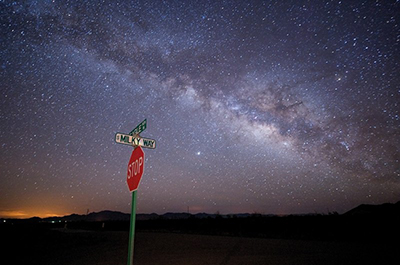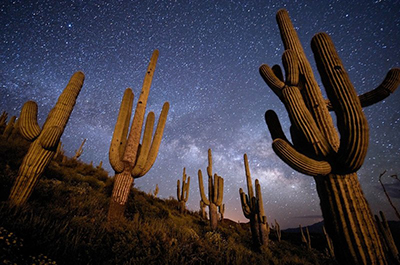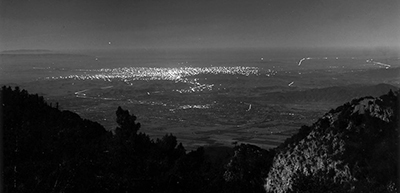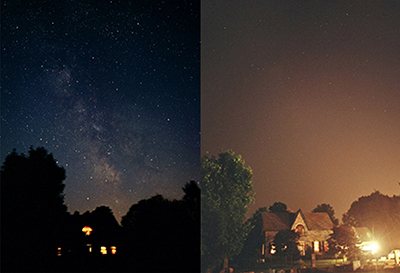
Nightskies are at best in national parks
On clear, pristine nights when not a single cloud disrupts our view, we look up and remark on the beauty that is the night sky. Orion and the Big Dipper have never looked so real.
And yet, some of us may never know the true magnificence of the cosmos.
Every night, thousands upon thousands of lights spring to life, banishing away most of the night sky’s true splendor. City-dwellers, all across the world, rob themselves and many ecosystems of this natural resource.
 |
A typical nightsky in Arizona, where low light pollution makes thousands of stars visible to the naked eye. In some instances, galaxies such as the Milky Way become visible (Photo courtesy of Jim Richardson). |
But, a ray of hope does still exist. Under the protection of the United States government, the national parks boast some of the best dark skies in the world.
The Natural Sounds and Night Skies Division of the National Parks Service (NPS), in conjunction with individuals and organizations both within and without the NPS, works tirelessly to create and implement policies and strategies in their parks, to protect the night sky from the ever-encroaching danger of light pollution.
Across the world, light pollution continues to increase and block even more of the night sky from view.
A general study of light pollution across all the United States, conducted by Pierantonio Cinzano of the University of Padova, Italy and Christopher Elvidge of the National Oceanic and Atmospheric Administration’s National Geophysical Data Center, revealed a 6 percent annual increase between the years of 1947 to 2000.
While most national parks, like Death Valley, seem to be remotely located, light pollution from major urban areas, like Las Vegas, still impact the night sky visibility.
| At right, low levels of light pollution in regions east of Peridot, Ariz., create a perfect viewing environment for stars and the Milky Way. Below, the city lights of Los Angeles brighten the entire valley and sky, blocking out all the stars. Urban development has led to the complete destruction of night sky visibility over Los Angeles (Photos courtesy of Jim Richardson). |  |
“The city of Las Vegas can be seen as a bright semi-circle of light on the horizon in parts of Death Valley,” said Chad Moore, Night Skies Program Manager of the NPS’s Night Sky Team.
Dan Duriscoe, the NPS’s Night Sky Team GIS Specialist, wrote in his report, “Preserving Pristine Night Skies in National Parks and the Wilderness Ethic,” that “today, we are on the verge of losing the pristine night sky entirely in the 48 contiguous states. However, unlike losing a species to extinction, topsoil to erosion, or yet-to-be-explored virgin lands to development, the night sky is 100 percent recoverable.”
This is where the Night Sky Programs in the NPS come in. The implementation of efficient light-use policies and management, combine to create an area of protected space where night sky visibility is at its best.
National parks known for their night skies, like Death Valley and Bryce Canyon, implement strict policies, sponsor astronomy and educational programs, and boast talented teams of specialized night sky park rangers.
Bryce Canyon National Park is known for its night sky programs hosted by a dedicated group of rangers and volunteer astronomers known as the Dark Rangers.
L ed and founded by Kevin Poe, their mission is to protect the night sky and educate the masses on astronomy and light pollution.
ed and founded by Kevin Poe, their mission is to protect the night sky and educate the masses on astronomy and light pollution.
It is the Dark Rangers who have ensured that Bryce Canyon’s view of the night sky remains to be one of the most pristine in the world.
“Because we were so focused on astronomy and night sky preservation, we relabeled ourselves ‘Dark Rangers,’” said Kevin Poe. “Bryce Canyon then became the academy for teaching other park rangers, not only astronomy, but all the issues surrounding light pollution and how to heighten awareness to a global public and we’re in a situation here at Bryce where 60 percent of our visitation comes from outside the country, so we truly do have access to a global audience.”
The Dark Rangers have been so effective in their protection and education campaigns, that according to the NPS, 7,500 stars can be seen on a moonless night in Bryce Canyon and Venus will cause visitors to cast shadows.
To ensure that places like Death Valley and Bryce Canyon National Parks exist all around the world, the International Dark-Sky Association (IDA) was founded in 1988.
The IDA sponsors educational programing and research to educate people everywhere about the dangers of light pollution and proper light management. Additionally, the IDA designates areas with pristine night skies and strict light management policies as International Dark Sky Parks (IDSP).
 |
The city lights of Los Angeles in 1908 seem of little consequence in the vastness of the surrounding area. |
There are three different tiers of IDSP designations: Bronze, Silver, and Gold. Each designation denotes a different level of dark sky quality, in increasing order.
In addition to national parks, both public (federal and state) and private lands are able to apply for this designation.
“We have parks like national parks, such as Big Bend and Death Valley, but we also have smaller state parks and even privately-owned lands like Goldendale Observatory,” said Ameé Hennig, the IDA Program Manager working directly with the parks and their applications. “We try to encourage quite a variety of people to apply.”
The application process for IDSP designation is a very rigorous and expensive process, through which applicants must retrofit all the lighting on the land to meet strict requirements and prepare an extensive report of sky quality data, letters of recommendation especially from IDA members and an intensive light management plan.
| CUTLINE GOES HERE |
“It is important for the parks to have a very strong light management plan that’s going to protect the skies in the future, educational outreach programming that’s needed to educate people about dark skies and their importance,” said Hennig. “Also, of course, they need to complete a lighting survey and retrofit in order to be successful.”
It is in this process that the Natural Sounds and Night Skies Division of the NPS is critical. This organization is unrivaled in their light pollution and sky quality research in the United States.
Death Valley National Park just recently received this designation after a long process of retrofitting the park to meet this high level of efficient light use and management.
“The entire process took about three years to complete, including the retrofitting of the lights which was a major part of that process,” Moore said.
 |
The effects of light pollution on the night sky can be seen in this side-by-side comparison of a house in Goodwood, Ontario, Canada, before and after a blackout in 2003 (Photos courtesy of Todd Carlson, Skynews). |
According to the Death Valley application, all the inefficient and unshielded lights throughout the park were removed and replaced with shielded and low-watt fixtures. This process was guided by five principles of warranting (light only where needed), controls (only when needed), shielding (directed downward), spectrum (lamps minimizing harmful effects), intensity (minimum light necessary), and efficiency.
In like fashion, Bryce Canyon is in the process of assembling its application for IDSP designation.
The Dark Rangers, along with other members of the NPS and astronomical and geological societies, are researching the parks night sky quality and resources, along with retrofitting the park.
It is the hope of the Natural Sounds and Night Skies Division, the IDA, and rangers like the Dark Rangers, that National Parks across the United States will become International Dark Sky Parks and protect the quality of our night skies.

Comments are Closed